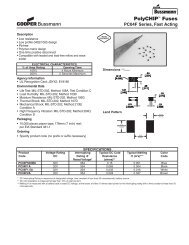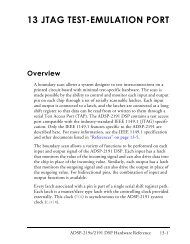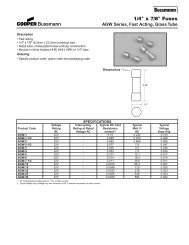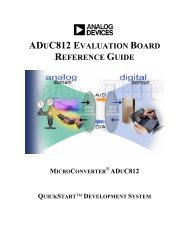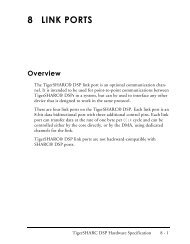ADSP-219x/2191 DSP Hardware Reference, Introduction
ADSP-219x/2191 DSP Hardware Reference, Introduction
ADSP-219x/2191 DSP Hardware Reference, Introduction
Create successful ePaper yourself
Turn your PDF publications into a flip-book with our unique Google optimized e-Paper software.
<strong>A<strong>DSP</strong></strong>-<strong>219x</strong> Architecture Overviewefficiently implement numeric format control, including multiword andblock floating-point representations.Register-usage rules influence placement of input and results within thecomputational units. For most operations, the computational units’ dataregisters act as a data register file, permitting any input or result register toprovide input to any unit for a computation. For feedback operations, thecomputational units let the output (result) of any unit be input to anyunit on the next cycle. For conditional or multifunction instructions,there are restrictions limiting which data registers may provide inputs orreceive results from each computational unit. For more information, see“Multifunction Computations” on page 2-58.A powerful program sequencer controls the flow of instruction execution.The sequencer supports conditional jumps, subroutine calls, and lowinterrupt overhead. With internal loop counters and loop stacks, the<strong>A<strong>DSP</strong></strong>-<strong>2191</strong> executes looped code with zero overhead; no explicit jumpinstructions are required to maintain loops.Two data address generators (DAGs) provide addresses for simultaneousdual operand fetches (from data memory and program memory). EachDAG maintains and updates four 16-bit address pointers. Whenever thepointer is used to access data (indirect addressing), it is pre- or post-modifiedby the value of one of four possible modify registers. A length valueand base address may be associated with each pointer to implement automaticmodulo addressing for circular buffers. Page registers in the DAGsallow circular addressing within 64K word boundaries of each of the 256memory pages, but these buffers may not cross page boundaries. Secondaryregisters duplicate all the primary registers in the DAGs; switchingbetween primary and secondary registers provides a fast context switch.Efficient data transfer in the core is achieved by using internal buses:• Program Memory Address (PMA) Bus• Program Memory Data (PMD) Bus1-8 <strong>A<strong>DSP</strong></strong>-<strong>219x</strong>/<strong>2191</strong> <strong>DSP</strong> <strong>Hardware</strong> <strong>Reference</strong>



